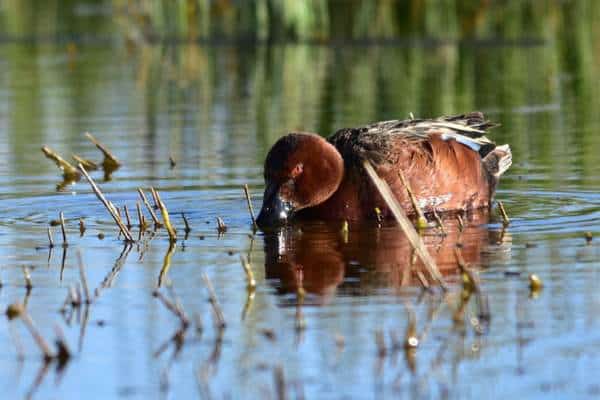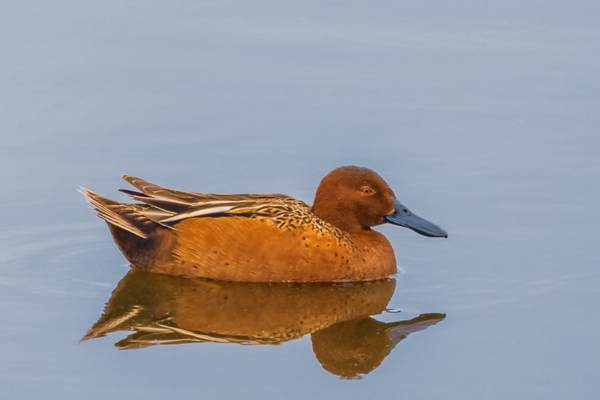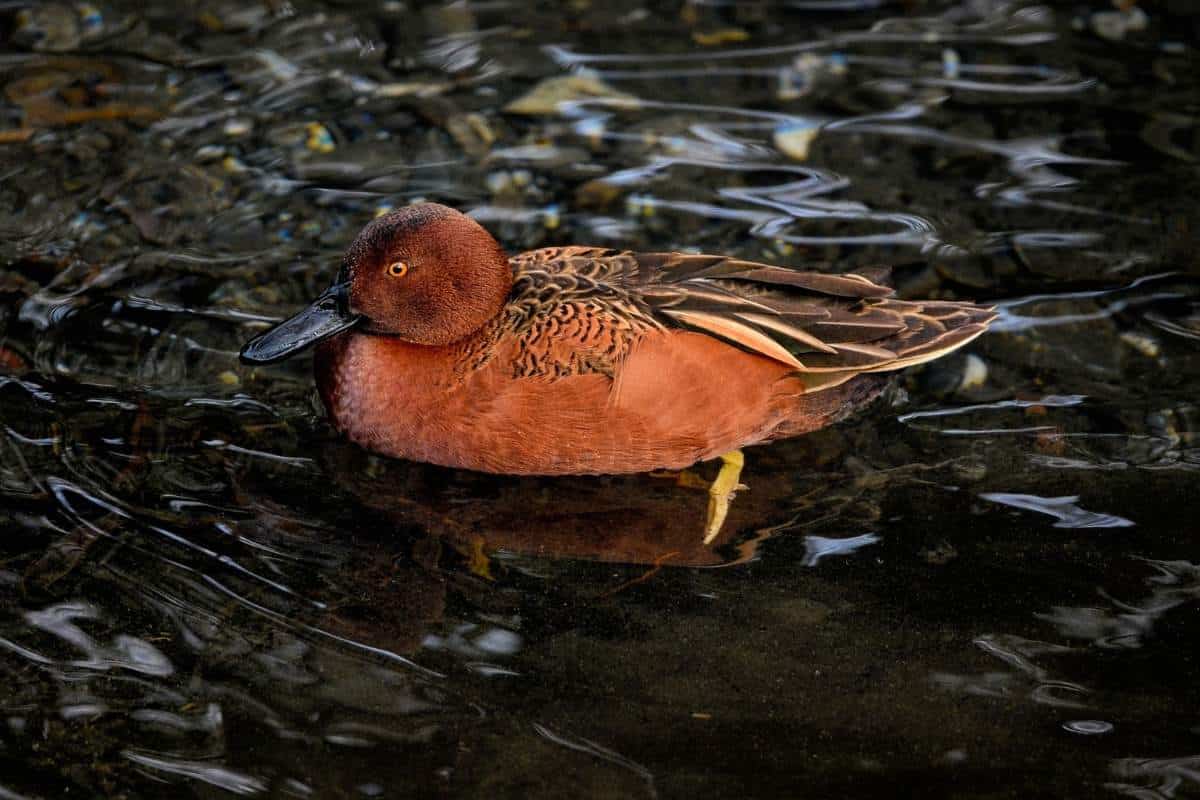Common Name: Cinnamon Teal
Scientific Name: Anas cyanoptera| Size | Diet | Range in Hawaii | Status in Hawaii |
|---|---|---|---|
| 14 in. - 16 in. | seeds, stems, leaves, and roots | Oahu, Kauai, and Maui | Least Concern |
Welcome to the vibrant world of the Cinnamon Teal (Anas cyanoptera), a captivating waterfowl species that dazzles with its striking appearance and unique characteristics. Join us as we explore its distinct features, from its exquisite coloration to its remarkable adaptations for survival in wetland environments.
Let’s embark on a journey to uncover the secrets and wonders of this remarkable duck species in this article..
Cinnamon teal
Appearance

The Cinnamon Teal is a small and strikingly colored duck found in the Americas. The breeding male is a sight to behold with its vibrant cinnamon-red head and upper neck, which contrasts beautifully with the dark brown back and sides. Its underparts are mottled brown, adorned with fine black barring.
The wings of the male are primarily gray, but what truly catches the eye is the brilliant blue patch, known as the speculum, on the secondary feathers. This combination of colors creates a stunning display.
In contrast, the female Cinnamon Teal is more subtly colored, with overall brown plumage and a mottled pattern on the body.
Adult males typically measure between 14-16 inches in length, while females are slightly smaller, measuring between 13-15 inches in length. The wingspan of the Cinnamon Teal is typically around 24-28 inches.
Diet
The Cinnamon Teal has a diverse diet that includes both plant matter and small invertebrates. The bulk of its diet consists of various aquatic plants, including seeds, stems, leaves, and roots. It feeds on a wide array of submerged vegetation such as pondweeds, smartweeds, and sedges, as well as emergent plants like bulrushes and cattails.
Behavior

The Cinnamon Teal displays a range of behaviors that are typical of dabbling ducks. Its feeding behavior involves dabbling in shallow water, where it submerges its head and upends its body to access underwater vegetation and invertebrates. This species is also skilled in flight, capable of swift and direct movements, often flying in V-shaped formations during migration.
Cinnamon Teals are social birds, commonly found in small to large flocks, particularly during the non-breeding season when they associate with other duck species. During courtship, males engage in elaborate displays, including head-bobbing, wing-flapping, and vocalizations to attract females.
Nesting
Cinnamon Teals nest in dense vegetation near water bodies. The female takes the lead in nest building, constructing a shallow depression on the ground or in dense vegetation. The nest is typically lined with grass, leaves, and down feathers to provide insulation and comfort for the eggs.
The female carefully arranges the materials to form a well-hidden and camouflaged nest, helping to protect it from potential predators. Once the nest is complete, the female lays a clutch of 5-12 creamy white or pale greenish eggs. She incubates the eggs for about 21-25 days, diligently keeping them warm and protected.
During this incubation period, the female may leave the nest briefly to feed and stretch her wings, but she quickly returns to continue incubation. After hatching, the precocial ducklings leave the nest within a day, following their mother to nearby water bodies where they begin their journey of growth and development. The female provides care and protection to the ducklings until they are capable of independent survival.
Habitat

Cinnamon Teals can be found in a range of wetland environments, including marshes, ponds, lakes, and freshwater wetlands. They are most commonly associated with shallow, freshwater habitats, although they can also be found in brackish marshes and coastal estuaries.
Range
The Cinnamon Teal is a vagrant species in Hawaii, which means it is not a regular or established resident of any specific island in the state. However, it has been spotted on occasion in wetland areas and other suitable habitats on several of the Hawaiian Islands, including Oahu, Kauai, and Maui.
Conservation Status
The International Union for Conservation of Nature (IUCN) has categorized it as a species of least concern due to its wide distribution and relatively stable population.
Interesting Facts
1. Cinnamon Teals have specialized adaptations for feeding
They have comb-like projections on the inside of their bills, called lamellae, which help filter out water while retaining small food particles like seeds and invertebrates.
2. Male Cinnamon Teal produces a distinct whistling call
The male Cinnamon Teal produces a distinct whistling call, often described as a “wee-oo” or “wee-wee-wee,” which is a characteristic sound associated with this species.
3. They occasionally engage in brood parasitism
Cinnamon Teals occasionally engage in brood parasitism, where females lay their eggs in the nests of other duck species, relying on them to incubate and raise their offspring.
4. They undertake altitudinal migration
Some Cinnamon Teal populations undertake altitudinal migration, moving to higher elevations during the non-breeding season and descending to lower elevations for breeding. This allows them to adapt to varying environmental conditions and resource availability.
5. They are diurnal birds
Cinnamon Teals are diurnal birds, meaning they are primarily active during daylight hours. However, during the breeding season, they may also engage in nocturnal behaviors, such as foraging and social interactions, particularly during low-light conditions.
Frequently Asked Questions
1. How long do Cinnamon Teals live?
In the wild, the average lifespan of Cinnamon Teals ranges from 5 to 10 years. However, some individuals have been known to live longer.
2. Can Cinnamon Teals hybridize with other duck species?
Yes, Cinnamon Teals can hybridize with other duck species, particularly the Blue-winged Teal. This can result in hybrid offspring with characteristics of both species.
3. Can Cinnamon Teals tolerate saltwater habitats?
While they generally prefer freshwater environments, they can occasionally be seen in brackish marshes and coastal estuaries. However, they are not as adapted to saline or saltwater habitats as some other duck species.
4. How fast can Cinnamon Teals fly?
Cinnamon Teals are agile flyers capable of swift and direct flight. While their flight speed can vary, they can typically reach speeds of up to 40-50 miles per hour (64-80 kilometers per hour).
5. Do Cinnamon Teals undergo molting?
Yes, like most ducks, Cinnamon Teals undergo a molting process. Molting is the shedding and replacement of feathers, usually occurring after the breeding season. During molting, they become flightless for a short period as new feathers grow in.




